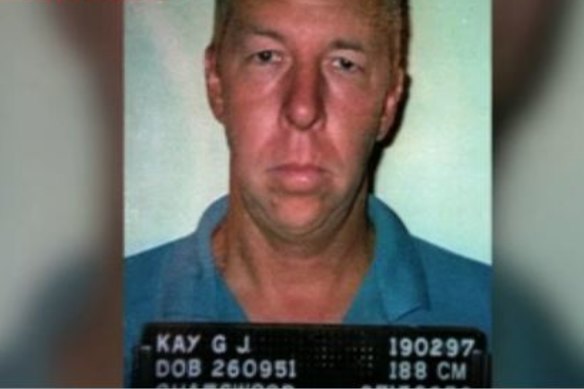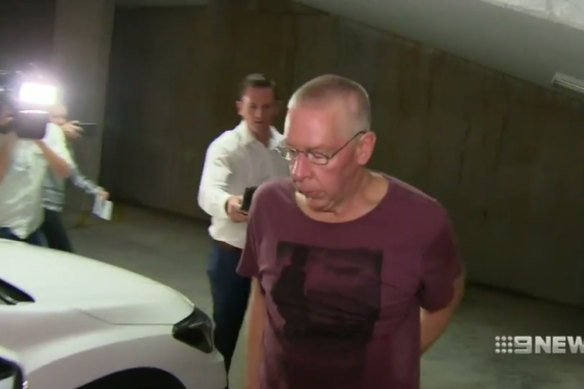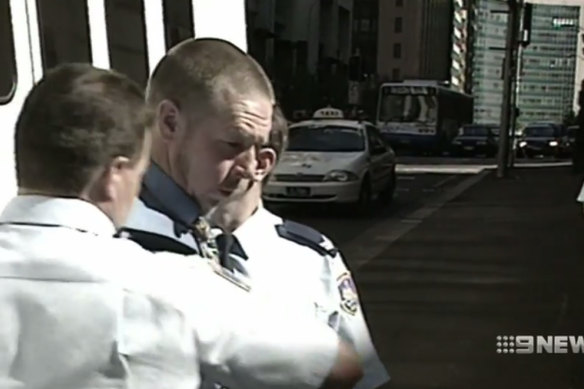By Sally Rawsthorne and Perry Duffin
Warning: this story contains graphic content
The “North Shore Rapist” always moved in the shadows, first during his brutal sexual attacks on eight women and girls, and later in the legal system after he convinced a court to suppress his name.
That’s now over and Graham James Kay can be revealed again as the infamous criminal whose latest crimes have been kept secret.

Graham James Kay always moved in the shadows.Credit: Seven News
The Herald can also reveal how the state of NSW twice watered down Kay’s release conditions before he went on to commit further offences against women.
Who is Graham Kay and what did he do?
Kay, now 73, had a history of indecently assaulting women and public masturbation going back to 1970. However, between 1995 and 1996, he committed a series of vicious sexual assaults on eight women and teenage girls, following them home and raping them at knifepoint in a year-long reign of terror.
He became known as the North Shore Rapist because he attacked women and girls in Balgowlah, Artarmon, Epping, Eastwood and Wollstonecraft.
Kay planned his attacks, grabbing his victims from behind and holding a knife to their necks. He was caught in a 1997 police operation that found him driving around looking for women and following them in Macquarie Park, Glebe and Epping.
He was sentenced to 20 years in prison and was paroled after 18 years behind bars in 2015.
“[His crimes were] calculated to instil in at least some of his victims the fear of death with the concomitant loss of all that life holds, at least unless they bowed to his demands,” sentencing judge Robert Shallcross Hulme said in 2000.
Kay had worked as a graphic artist and was a former volunteer firefighter before his arrest.
What restrictions has he been under since he was released?
Authorities feared Kay remained a danger to women in Sydney and convinced the NSW Supreme Court to put him on an Extended Supervision Order in 2017.
The ESO forced Kay to wear an electronic ankle monitor and submit a schedule of movements to ensure he did not deviate from known locations.
The same year, Kay asked for his name to be suppressed but failed because the media argued he was already a notorious sex offender, which the judge accepted.
Then the serial rapist in 2018 had his monitoring tag removed. Within weeks, he walked into a Woolworths in Sydney’s west and kissed a recoiling teenage girl on the cheek.

Graham James Kay in 2018.Credit: Nine News
Justice Sarah McNaughton on Tuesday said the girl was aware of Kay’s horrific past because of news reports – and that could have been “protective” for her.
“That publicity likely helped to escalate the matter such that it was reported to the police, leading to [Kay] being charged,” the judge wrote.
Three days later, his supervisors discovered he had a sex worker in his home – a breach of his conditions.
Kay served four months in prison for those breaches and was released. His sentence for attacking the child was only a good behaviour bond.
How did Kay get his name suppressed?
In 2020, the state of NSW asked Justice Stephen Rothman to put Kay on a second ESO.
Despite Kay’s breaches in 2018, the state of NSW removed the requirement for Kay to provide his schedule of movements in the second ESO, though he would still wear an ankle monitor.
Kay told Rothman that the negative media attention had cost him family and friends, jobs and housing.

Kay was sentenced to 20 years in jail after attacking eight women and teenage girls in the 1990s.Credit: Nine News
The judge said negative press and threats would “significantly impact upon [Kay’s] capacity to continue any process of rehabilitation” and suppressed Kay’s name.
Did Kay rehabilitate – or reoffend in secret?
Kay, in January 2022, followed a woman walking around Sydney’s Queen Victoria Building and went on to commit the worst offence since his release.
CCTV cameras captured Kay stalking the woman through the shops before following her home and sneaking into her unit tower.
“As he exited the lift, he placed his right hand under the complainant’s dress, placing it over her underwear and touching her genitalia. She took evasive action, screamed and managed to gain entry to her apartment without [Kay],” a Supreme Court judge would later say.
“She was significantly traumatised by these events.”
In May of that year, Kay was convicted of stalking and sexual touching. He was sentenced to two years and six months on appeal but granted parole in September 2023.
Why is Kay in the news again?
When the state of NSW applied for a third ESO against Kay earlier this year, Kay asked for his name to be kept secret for the third time.
Kay argued that secrecy would assist his rehabilitation and avoid risks to his safety. Kay pointed to negative comments on social media about him and the vandalism of his car.
The Herald intervened in the case, asking the NSW Supreme Court to revoke the suppression order over the serial rapist’s name.
The masthead’s lawyers argued that secrecy for the past four years had clearly not rehabilitated Kay, and there was no real risk to his safety.
On Tuesday, a judge removed the suppression order, finding that rehabilitation was not a legal basis for any suppression order and there was no imminent threat to Kay’s safety.
The win means the Herald can report that Kay has been out of prison for 10 months and quietly living in Sydney.
He has not had to tell his employers, friends or neighbours about his past.
How watering down Kay’s restrictions posed a danger to the public
The state of NSW twice watered down the restrictions on Kay after his release from prison in 2018.
The first, in 2018, came when Kay’s ankle monitor was removed. Shortly after, he assaulted the teenage girl, and the ankle monitor was reattached.
Then, in 2020, the state allowed Kay to move around the city however he pleased, a dramatic change from submitting a schedule to his supervisors ahead of leaving the house.
That schedule, along with the electronic ankle monitor, could have stopped him from attacking the woman in the CBD in 2022, a judge found.
“It may be that scheduling would have operated as a significant restraint upon (Kay’s) ability to stalk the victim for some two hours in and about the CBD shopping district and follow her home,” Justice Stephen Campbell said this year.
“His departure from his schedule of movements would have been obvious to those monitoring him electronically. More generally, electronic monitoring and scheduling are complementary; each is more protective of the community when the other is also in force.”
What happens next?
The state will continue its case for a third ESO over Kay, which can last for up to five years. If successful, the conditions will include both electronic monitoring and scheduled movements.
It represents a backflip of their previous position that Kay did not need both restrictions.
Support is available from the National Sexual Assault, Domestic Family Violence Counselling Service at 1800RESPECT (1800 737 732).